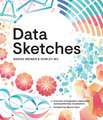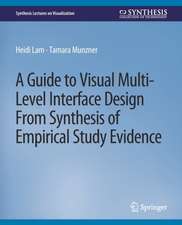Visualization Analysis and Design: AK Peters Visualization Series
Autor Tamara Munzneren Limba Engleză Hardback – dec 2014
Visualization Analysis and Design provides a systematic, comprehensive framework for thinking about visualization in terms of principles and design choices. The book features a unified approach encompassing information visualization techniques for abstract data, scientific visualization techniques for spatial data, and visual analytics techniques for interweaving data transformation and analysis with interactive visual exploration. It emphasizes the careful validation of effectiveness and the consideration of function before form.
The book breaks down visualization design according to three questions: what data users need to see, why users need to carry out their tasks, and how the visual representations proposed can be constructed and manipulated. It walks readers through the use of space and color to visually encode data in a view, the trade-offs between changing a single view and using multiple linked views, and the ways to reduce the amount of data shown in each view. The book concludes with six case studies analyzed in detail with the full framework.
The book is suitable for a broad set of readers, from beginners to more experienced visualization designers. It does not assume any previous experience in programming, mathematics, human–computer interaction, or graphic design and can be used in an introductory visualization course at the graduate or undergraduate level.
Preț: 459.35 lei
Preț vechi: 574.19 lei
-20% Nou
Puncte Express: 689
Preț estimativ în valută:
87.90€ • 93.99$ • 73.29£
87.90€ • 93.99$ • 73.29£
Carte disponibilă
Livrare economică 27 martie-10 aprilie
Livrare express 12-18 martie pentru 48.56 lei
Preluare comenzi: 021 569.72.76
Specificații
ISBN-13: 9781466508910
ISBN-10: 1466508914
Pagini: 428
Ilustrații: 189 colour illustrations, 2 colour tables
Dimensiuni: 191 x 235 x 23 mm
Greutate: 1.04 kg
Ediția:1
Editura: CRC Press
Colecția A K Peters/CRC Press
Seria AK Peters Visualization Series
Locul publicării:Boca Raton, United States
ISBN-10: 1466508914
Pagini: 428
Ilustrații: 189 colour illustrations, 2 colour tables
Dimensiuni: 191 x 235 x 23 mm
Greutate: 1.04 kg
Ediția:1
Editura: CRC Press
Colecția A K Peters/CRC Press
Seria AK Peters Visualization Series
Locul publicării:Boca Raton, United States
Public țintă
Academic and Professional Practice & DevelopmentCuprins
What's Vis, and Why Do It? What: Data Abstraction. Why: Task Abstraction. Analysis: Four Levels for Validation. Marks and Channels. Rules of Thumb. Arrange Tables. Arrange Spatial Data. Arrange Networks and Trees. Map Color and Other Channels. Manipulate View. Facet into Multiple Views. Reduce Items and Attributes. Embed: Focus+Context. Analysis Case Studies. Bibliography.
Recenzii
"Visualization is a young field with only a few primary texts available. What distinguishes this one is the way it synthesizes past work to develop a comprehensive framework for design and analysis. … The author builds a framework for understanding the key elements of visualization and develops a synthesis of current best practices. … The book is filled with examples from the universe of visualization. Virtually all the possibilities for visualization design are illustrated with specific examples. … This is an attractive book, one that’s likely to be a fundamental source for the field. It’s worth a look for anyone with even a passing interest."
—MAA Reviews, March 2015
"Munzner’s Visualization Analysis and Design is the first comprehensive textbook covering the topic of information visualization. She covers basic theory, careful analysis of the design space, design methodology, and numerous practical examples. Her taxonomic approach is ideally suited for use in the classroom to guide students through the many design decisions associated with creating effective visualizations."
—Chris North, Virginia Tech
"Visualization Analysis and Design does a fantastic job in providing a framework and language for analyzing, critiquing, and discussing visualizations. This book provides a wonderful foundation for the field."
—Miriah Meyer, University of Utah
"Visualization Analysis and Design is a book that fills the gaps in the existing literature. It offers a synthesized view and a framework most useful to guide the newcomer to visualization. The nested model that unifies design and evaluation is particularly enlightening. The book is truly valuable for an initial InfoVis course at the graduate level."
—Beatriz Sousa Santos, Universidade de Aveiro
"Munzner elegantly synthesizes an astounding amount of cutting-edge work on visualization into a clear, engaging, and comprehensive textbook that will prove indispensable to students, designers, and researchers."
—Steven Franconeri, Northwestern University
"A very detailed and thorough discussion of many topics central to information visualization. A must-read for researchers, sophisticated practitioners, and graduate students."
—Jim Foley, Georgia Institute of Technology
"Munzner's new book is thorough and beautiful. It belongs on the shelf of anyone whose work and life are touched and enriched by visualization."
—Chris Johnson, University of Utah
"Visualization is often presented in the classroom as a motley collection of techniques and algorithms designed to unearth insights from data. Tamara Munzner is one of the leading voices of the school that seeks to establish visualization as a discipline resting on well-understood pillars of perception, cognition, and interaction. This new volume from Tamara reflects her expansive views and presents visualization as a wholesome and essential topic for this age of Big Data and all things analytic."
—Raghu Machiraju, The Ohio State University
"Tamara Munzner is one of the world’s very top researchers in information visualization, and this meticulously crafted volume is probably the most thoughtful and deep synthesis the field has yet seen."
—Michael McGuffin, École de Technologie Supérieure
"Tamara Munzner shares her deep insights in visualization with us in this excellent textbook, equally useful for students and experts in the field. Highly structured, with many examples that illustrate the underlying framework."
—Jarke van Wijk, Eindhoven University of Technology
"This book provides the most comprehensive coverage of the fundamentals of visualization design that I have found. It is a much-needed and long-awaited resource for both teachers and practitioners of visualization."
—Kwan-Liu Ma, University of California, Davis
"Visualization is fundamental to meeting the unprecedented challenges and exploiting the wonderful opportunities of the ever-expanding deluge of data confronting virtually every field. Tamara Munzner’s new book provides a principled treatment of visualization design. This is the visualization textbook I have long awaited. It emphasizes abstraction, design principles, and the importance of evaluation and interactivity."
—Jim Hollan, University of California, San Diego
"Tamara Munzner is an outstanding scientist, a gifted scholar, and deeply cares about bringing research into practice … She is the driving force behind unifying methodology and terminology in the proliferating field of information visualization. Providing guidance, preventing mistakes, and showing best practices are the ingredients of the secret sauce that make this work so indispensable. The book puts together much of the wisdom she has accumulated over the years in a systematic, well-structured form and shapes the field of visualization in an unprecedented way. It helps to better understand problems, design better systems, avoid common mistakes, and better communicate results. Simply a must-read for everyone concerned with visualization!"
—Wolfgang Aigner, St. Pölten University of Applied Sciences
"Visualization Analysis and Design gives a framework that formalizes a notion of effective visualization. By connecting design choices with visualization idioms, Munzner provides readers with tools to both articulate the analysis of visualizations and to invent their own."
—Joshua A. Levine, Clemson University
"Without a doubt, Visualization Analysis and Design is the most comprehensive book on information visualization (InfoVis) to date … Perhaps what is most impressive about this book is its coverage in both the breadth and depth of relevant InfoVis techniques and topics. It will be immediately accessible to both newcomers and veterans of InfoVis who are interested in catching up to the state of the art. The book can be used both as a textbook in a classroom setting or as a reference book in any visualization research group."
—Remco Chang, Tufts University
"Visualization Analysis and Design is a pleasure to read for the students in my course. Tamara Munzner is striving to make visualization accessible to a very broad audience and is succeeding. This is a textbook we were waiting for."
—Torsten Möller, University of Vienna
"I like this book because it begins with providing a good way to think about visualization at a high level, and then follows through by providing the building blocks to use in achieving those goals. I think this book will be valuable to both researchers and practitioners because it provides well-grounded foundations as well as a framework to build upon them."
—Michael Gleicher, University of Wisconsin–Madison "This highly readable and well-organized book not only covers the fundamentals of visualization design, but also provides a solid framework for analyzing visualizations and visualization problems with concrete examples from the academic community. I am looking forward to teaching from this book and sharing it with my research group."
—Michele C. Weigle, Old Dominion University
"Dr. Munzner’s work is at the right balance of theory of application—it is not just focused on the why, which is important, but the how. Concrete guidance at every point of the visualization design process is provided, an invaluable resource for instruction and learning."
—T.J. Jankun-Kelly, Mississippi State University
—MAA Reviews, March 2015
"Munzner’s Visualization Analysis and Design is the first comprehensive textbook covering the topic of information visualization. She covers basic theory, careful analysis of the design space, design methodology, and numerous practical examples. Her taxonomic approach is ideally suited for use in the classroom to guide students through the many design decisions associated with creating effective visualizations."
—Chris North, Virginia Tech
"Visualization Analysis and Design does a fantastic job in providing a framework and language for analyzing, critiquing, and discussing visualizations. This book provides a wonderful foundation for the field."
—Miriah Meyer, University of Utah
"Visualization Analysis and Design is a book that fills the gaps in the existing literature. It offers a synthesized view and a framework most useful to guide the newcomer to visualization. The nested model that unifies design and evaluation is particularly enlightening. The book is truly valuable for an initial InfoVis course at the graduate level."
—Beatriz Sousa Santos, Universidade de Aveiro
"Munzner elegantly synthesizes an astounding amount of cutting-edge work on visualization into a clear, engaging, and comprehensive textbook that will prove indispensable to students, designers, and researchers."
—Steven Franconeri, Northwestern University
"A very detailed and thorough discussion of many topics central to information visualization. A must-read for researchers, sophisticated practitioners, and graduate students."
—Jim Foley, Georgia Institute of Technology
"Munzner's new book is thorough and beautiful. It belongs on the shelf of anyone whose work and life are touched and enriched by visualization."
—Chris Johnson, University of Utah
"Visualization is often presented in the classroom as a motley collection of techniques and algorithms designed to unearth insights from data. Tamara Munzner is one of the leading voices of the school that seeks to establish visualization as a discipline resting on well-understood pillars of perception, cognition, and interaction. This new volume from Tamara reflects her expansive views and presents visualization as a wholesome and essential topic for this age of Big Data and all things analytic."
—Raghu Machiraju, The Ohio State University
"Tamara Munzner is one of the world’s very top researchers in information visualization, and this meticulously crafted volume is probably the most thoughtful and deep synthesis the field has yet seen."
—Michael McGuffin, École de Technologie Supérieure
"Tamara Munzner shares her deep insights in visualization with us in this excellent textbook, equally useful for students and experts in the field. Highly structured, with many examples that illustrate the underlying framework."
—Jarke van Wijk, Eindhoven University of Technology
"This book provides the most comprehensive coverage of the fundamentals of visualization design that I have found. It is a much-needed and long-awaited resource for both teachers and practitioners of visualization."
—Kwan-Liu Ma, University of California, Davis
"Visualization is fundamental to meeting the unprecedented challenges and exploiting the wonderful opportunities of the ever-expanding deluge of data confronting virtually every field. Tamara Munzner’s new book provides a principled treatment of visualization design. This is the visualization textbook I have long awaited. It emphasizes abstraction, design principles, and the importance of evaluation and interactivity."
—Jim Hollan, University of California, San Diego
"Tamara Munzner is an outstanding scientist, a gifted scholar, and deeply cares about bringing research into practice … She is the driving force behind unifying methodology and terminology in the proliferating field of information visualization. Providing guidance, preventing mistakes, and showing best practices are the ingredients of the secret sauce that make this work so indispensable. The book puts together much of the wisdom she has accumulated over the years in a systematic, well-structured form and shapes the field of visualization in an unprecedented way. It helps to better understand problems, design better systems, avoid common mistakes, and better communicate results. Simply a must-read for everyone concerned with visualization!"
—Wolfgang Aigner, St. Pölten University of Applied Sciences
"Visualization Analysis and Design gives a framework that formalizes a notion of effective visualization. By connecting design choices with visualization idioms, Munzner provides readers with tools to both articulate the analysis of visualizations and to invent their own."
—Joshua A. Levine, Clemson University
"Without a doubt, Visualization Analysis and Design is the most comprehensive book on information visualization (InfoVis) to date … Perhaps what is most impressive about this book is its coverage in both the breadth and depth of relevant InfoVis techniques and topics. It will be immediately accessible to both newcomers and veterans of InfoVis who are interested in catching up to the state of the art. The book can be used both as a textbook in a classroom setting or as a reference book in any visualization research group."
—Remco Chang, Tufts University
"Visualization Analysis and Design is a pleasure to read for the students in my course. Tamara Munzner is striving to make visualization accessible to a very broad audience and is succeeding. This is a textbook we were waiting for."
—Torsten Möller, University of Vienna
"I like this book because it begins with providing a good way to think about visualization at a high level, and then follows through by providing the building blocks to use in achieving those goals. I think this book will be valuable to both researchers and practitioners because it provides well-grounded foundations as well as a framework to build upon them."
—Michael Gleicher, University of Wisconsin–Madison "This highly readable and well-organized book not only covers the fundamentals of visualization design, but also provides a solid framework for analyzing visualizations and visualization problems with concrete examples from the academic community. I am looking forward to teaching from this book and sharing it with my research group."
—Michele C. Weigle, Old Dominion University
"Dr. Munzner’s work is at the right balance of theory of application—it is not just focused on the why, which is important, but the how. Concrete guidance at every point of the visualization design process is provided, an invaluable resource for instruction and learning."
—T.J. Jankun-Kelly, Mississippi State University
Notă biografică
Tamara Munzner (University of British Columbia, Vancouver, Canada) (Author)
Descriere
This book provides a systematic, comprehensive framework for thinking about visualization in terms of principles and design choices. It features a unified approach encompassing information visualization techniques for abstract data, scientific visualization techniques for spatial data, and visual analytics techniques for interweaving data transformation and analysis with interactive visual exploration. Suitable for both beginners and more experienced designers, the book does not assume any experience with programming, mathematics, human–computer interaction, or graphic design.



































